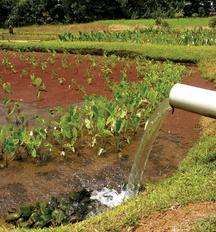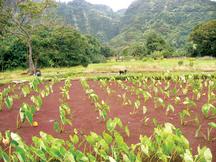East Maui taro farmers facing big challenges
by Rob ParsonsJune 12, 2008
 |
 |
 |
More of this is needed
"I want to farm, so I gotta fight for water."
-Wailuanui taro farmer Steven Ho'okano
Each day, a steady stream of rental cars and vans traverses the serpentine roads to East Maui and many of those traveling the Hana Highway pull over to photograph the stunning view at the Wailua Lookout. Below is a picturesque snapshot of a time gone by, with historic churches, quaint family homes, and taro patches.
But unlike the steady flow of traffic, the streams nourishing the once-verdant Wailuanui Valley have been reduced to a trickle. Hawaiian families that have worked the taro lo'i for generations are eking out an existence, struggling to keep their farms, way of life, and their culture alive.
"This whole valley was once open taro patches," spoke taro-grower Norman "Bush" Martin, sweeping his arm from left to right and pointing to the steep valley walls that delineate Wailuanui. "All the way from the river to over there, and all the way to the ocean. Was all open taro patches."
Dating back to pre-contact times, the elaborate auwai or ditch system that brings water to the valley from three sources has nearly run dry. Early summer drought conditions are a factor, but the greater concern is the amount of water diverted by East Maui Irrigation (EMI) transporting water to central Maui sugar cane fields at rates ranging from 160 million to 450 million gallons daily, depending on seasonal conditions.
Begun in 1876, the EMI diversion of East Maui streams has continued for well over a century, and is currently used to irrigate and process 36,000 acres of sugar, with a small fraction- about eight million gallons- being treated for the upcountry drinking water supply.
 |
 |
 |
Young taro in Wailuanui Valley
But, the original lease to Alexander & Baldwin, parent company to Hawaiian Commercial & Sugar (HC&S) and EMI, states, "subject to the condition that there be no injury to the water rights of downstream land owners."
"Water is life," said 35-year old taro farmer Steven Ho'okano. "They draining the life out of us."
Ho'okano is growing taro in his uncle's lo'i, or patches, because there is not enough water on his own land. He once worked in the tourist industry, as a hotel worker. "I had a calling to come home," he said. "I asked myself, 'what am I doing? I gotta grow taro,' It's my kuleana, I came back to my roots."
Ho'okano and Martin led me through the valley, showing the severe impacts of too little water. Banks of the ditches were dry, cracked, and weedy. Many patches were not planted, lying fallow and chest high with weeds. While some taro patches had water flowing through them, others, nearly ready to harvest, were bone dry.
Water must not only be available to nourish the taro and discourage weeds, but it must be cold enough to provide optimal growth. "You can't put in warm water, no way," said Ho'okano. "Hot water cooks the taro. They get disease. You cut them open and it looks like guava seed."
The lehua variety of taro takes nine to twelve months to be ready for harvest, while the moi variety can take longer, 16 months or more. "If it's rotten," said Martin, "you lost time and money. It must be flowing, cool, steady water."
"Everybody in this place works really hard," said Ho'okano. "This is our church, where we find peace of mind. Where our heart is."
Sufficient cool water in the early stages of planting also helps drown out weeds. In later stages, it doesn't make sense to pull weeds, as it can harm the developing taro corms. "We can't weed when they stay like this," said Ho'okano, looking over one of his patches. "It does more damage than good, it disturbs the taro.
"Taro, you gotta watch 'em like kids. They need a lot of love, and everything."
Ho'okano's love for the taro and for practicing the farming lifestyle at his cultural roots has led him to become active in a variety of issues. He helped organize an educational demonstration the weekend of Hana's Taro Festival in late April, holding signs along the highway and providing printed pamphlets to passers-by.
He is among many East Maui Hui residents who traveled to Kahului on three occasions to protest the arrival of Hawaii Superferry, believing it will increase pressure on the limited resources of their area. He noted that Superferry passengers have already been discovered with large stashes of 'opihi and edible limu, attempting to take it back to Oahu for commercial sale.
"Even though we live in a beautiful place," said Ho'okano, "our resources are being tapped."
Ho'okano also took part in protests at the state capital in Honolulu last January, seeking a ten-year moratorium on genetic research for taro. UH researchers insist they are interested in developing disease-resistant varieties.
The moratorium bill passed the Senate before being stalled in the House Agriculture Committee, and legislators will revisit the bill next year.
"We don't need GMO, we need water," said Ho'okano. He also noted that their kupuna knew that kukui nuts had anti-fungal properties and would put them in the ground along with the taro. "If the taro is all palahu (rotten)," he said, "you no can use the cuttings, either. Everybody is sharing cuttings.
"This is who we are. It's our culture, our identity. If the taro die, we die."
The legal efforts to restore stream flows in East Maui were begun seven years ago by Wailuanui taro farmer Ed Wendt and others, with the assistance of the Native Hawaiian Legal Corporation (NHLC). While their petition by law should have been ruled upon with 180 days, to date there still has not been a lawful determination on water allocation.
A recent public scoping meeting held at the Haiku Community Center by the state Commission for Water Resource Management (CWRM) boiled over with frustration at the process. No CWRM members were in attendance, only staff, and EMI officials were targeted as the cause of the discontent.
Moreover, much of EMI's diverted water is taken from state lands-33,000 acres actually are crown lands, or lands native Hawaiians never surrendered.
"These lands should be used to support Hawaiian culture," said NHLC attorney Alan Murakami, "rather than used as a resource, taken by a private entity without regard for these rights. Quoted in the Hanaside News, Murakami continued, "What are we doing here? Depriving Hawaiians, who have suffered for decades, of water they need to sustain their culture."
When EMI and A&B sought to extend their yearly water leases from year-to year bids to a thirty-year agreement in 2002, many spoke out and intervened. Judge Eden Hifo refused the long-term lease, and ruled that the state must first determine how much water needed to be released to protect native water rights in 27 streams on Haleakala's windward slopes.
The Department of Land & Natural Resources determined there must be a stream monitor, though two previous monitors have since been reassigned.
In March, 2008, the CWRM issued a 100-page draft public review document, the Wailuanui Instream Flow Assessment Report. However, the issuance of the study, filled with colorful maps, tables, and historical data, has yet to result in more water being returned to those who have farmed taro for generations.
"All the laws are in our favor," said Ho'okano, "but nobody like enforce them. Not just me and Bush, but everybody's got cracks in their taro patches. No more water."
In the summertime, the growers said, everyone wants poi for parties and graduation. "My cousin graduated last week," said Martin. "I had to tell him I can't make poi."
Martin also provides taro to the Aloha Poi Factory in Wailuku. Sometimes he can only provide half of an order, forty pounds out of eighty. He once was able to pull 25-30 bags a week, with each bag weighing 85-90 pounds.
"Now, maybe two bags a week," said Martin, "and half the year, cannot pull."
In the old days, farmers used to carry out 100 pound bags from the back of the valley, historically one of the most important growing regions on the island. A 1995 study based on an aerial survey noted 339 separate taro lo'i.
Now, farmers access their fields with the help of quad-track all-terrain vehicles, over a series of trails and wooden bridges. Rising gas prices also affect them, as weed-eaters, tillers, and mowers are utilized to complement the handwork of taro cultivation.
"This was a sustainable community for generations," said Ho'okano. "Now, we struggling. We need water, brah. What's happening here is cultural genocide."
Still Ho'okano sees promise in the fallow patches. "The closed patches is the healing, waiting for the water. Underneath, the worms are doing their job. The world looks pretty bad right now as far as sustainable. We gotta learn how to be sustainable."